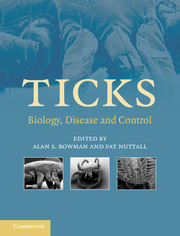Book contents
- Frontmatter
- Contents
- List of contributors
- Preface
- 1 Systematics and evolution of ticks with a list of valid genus and species names
- 2 The impact of tick ecology on pathogen transmission dynamics
- 3 Tick salivary glands: the physiology of tick water balance and their role in pathogen trafficking and transmission
- 4 Tick saliva: from pharmacology and biochemistry to transcriptome analysis and functional genomics
- 5 Tick toxins: perspectives on paralysis and other forms of toxicoses caused by ticks
- 6 Tick lectins and fibrinogen-related proteins
- 7 Endocrinology of tick development and reproduction
- 8 Factors that determine sperm precedence in ticks, spiders and insects: a comparative study
- 9 Tick immunobiology
- 10 Saliva-assisted transmission of tick-borne pathogens
- 11 Lyme borreliosis in Europe and North America
- 12 Viruses transmitted by ticks
- 13 Babesiosis of cattle
- 14 Theileria: life cycle stages associated with the ixodid tick vector
- 15 Characterization of the tick–pathogen–host interface of the tick-borne rickettsia Anaplasma marginale
- 16 Emerging and emergent tick-borne infections
- 17 Analysing and predicting the occurrence of ticks and tick-borne diseases using GIS
- 18 Acaricides for controlling ticks on cattle and the problem of acaricide resistance
- 19 Anti-tick vaccines
- 20 Anti-tick biological control agents: assessment and future perspectives
- 21 Pheromones and other semiochemicals of ticks and their use in tick control
- Index
- References
11 - Lyme borreliosis in Europe and North America
Published online by Cambridge University Press: 21 August 2009
- Frontmatter
- Contents
- List of contributors
- Preface
- 1 Systematics and evolution of ticks with a list of valid genus and species names
- 2 The impact of tick ecology on pathogen transmission dynamics
- 3 Tick salivary glands: the physiology of tick water balance and their role in pathogen trafficking and transmission
- 4 Tick saliva: from pharmacology and biochemistry to transcriptome analysis and functional genomics
- 5 Tick toxins: perspectives on paralysis and other forms of toxicoses caused by ticks
- 6 Tick lectins and fibrinogen-related proteins
- 7 Endocrinology of tick development and reproduction
- 8 Factors that determine sperm precedence in ticks, spiders and insects: a comparative study
- 9 Tick immunobiology
- 10 Saliva-assisted transmission of tick-borne pathogens
- 11 Lyme borreliosis in Europe and North America
- 12 Viruses transmitted by ticks
- 13 Babesiosis of cattle
- 14 Theileria: life cycle stages associated with the ixodid tick vector
- 15 Characterization of the tick–pathogen–host interface of the tick-borne rickettsia Anaplasma marginale
- 16 Emerging and emergent tick-borne infections
- 17 Analysing and predicting the occurrence of ticks and tick-borne diseases using GIS
- 18 Acaricides for controlling ticks on cattle and the problem of acaricide resistance
- 19 Anti-tick vaccines
- 20 Anti-tick biological control agents: assessment and future perspectives
- 21 Pheromones and other semiochemicals of ticks and their use in tick control
- Index
- References
Summary
INTRODUCTION
Arthropod-borne spirochaetes have long caused human suffering and disease. Louse-borne relapsing fever (LBRF), caused by Borrelia recurrentis and transmitted by the human body louse (Pediculus humanus), was once widespread in the extensive areas where human body lice were found. Today, LBRF is reported mainly from northeastern and central Africa including the countries of Ethiopia, Somalia and Sudan, in discrete foci where human body lice remain prevalent (Porcella et al., 2000). Tick-borne relapsing fever (TBRF) was first described in Africa where the argasid (soft) tick Ornithodoros moubata was found to transmit Borrelia duttoni (see historical review by Burgdorfer, 2001). Isolated endemic cycles of TBRF caused by individual species of relapsing fever spirochaetes and their matching argasid vector species have been described in Asia, Europe and the Americas (Felsenfeld, 1979). Recent reports detailing the epidemiology and biology of relapsing fever include studies in Tanzania, where B. duttoni frequently causes human disease (Melkert & Stel, 1991; Fukunaga et al., 2001), as well as studies in North America where Borrelia hermsii is the primary aetiologic agent of relapsing fever (Dworkin et al., 2002). Although Borrelia spp. were known to cause human disease in isolated pockets, scant attention was directed towards the study of these organisms in the latter half of the twentieth century until an epidemic of arthritis was described in Lyme, Connecticut (Steere et al., 1977b).
- Type
- Chapter
- Information
- TicksBiology, Disease and Control, pp. 220 - 252Publisher: Cambridge University PressPrint publication year: 2008
References
- 10
- Cited by



